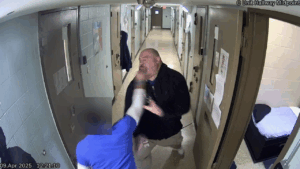Escalating Violence at Indian River Juvenile Correctional Facility Raises Concerns
 In an alarming series of reports, the Department of Youth Services (DYS) has confirmed at least 62 youth-on-staff assaults at the Indian River Juvenile Correctional Facility this year, a trend that raises significant concerns among union leaders and lawmakers alike. The facility, which has been grappling with escalating violence for several years, has become a focal point for discussions about safety and rehabilitation within Ohio’s juvenile justice system.
In an alarming series of reports, the Department of Youth Services (DYS) has confirmed at least 62 youth-on-staff assaults at the Indian River Juvenile Correctional Facility this year, a trend that raises significant concerns among union leaders and lawmakers alike. The facility, which has been grappling with escalating violence for several years, has become a focal point for discussions about safety and rehabilitation within Ohio’s juvenile justice system.
During the week of April 8, the situation reached a critical point, with at least 11 reported assaults and disturbances involving staff. One particularly shocking incident involved two teenagers attacking a teacher with a hammer, which necessitated hospitalization for the educator. Such incidents have become increasingly common at Indian River, prompting questions about the facility’s environment and the safety of its staff.
Footage from inside the facility reveals a troubling picture. In various incidents caught on video, juveniles used makeshift weapons such as brooms to assault staff members, physically attacked employees during interactions, and even filled common areas with smoke from a fire extinguisher after instigating physical confrontations. One staff member was even subjected to a cup of liquid thrown in their face. These actions illustrate a chaotic atmosphere that not only endangers staff but also jeopardizes the rehabilitation process for the youth incarcerated there.
Christopher Mabe, president of the Ohio Civil Service Employees Association, expressed his alarm over the recent uptick in violence. “Nothing surprises me at this point,” he stated. Mabe highlighted the lack of significant policy changes that might mitigate the violence, stressing that the ongoing assaults contribute to difficulties in retaining qualified staff. He pointed out that as of August, Indian River was understaffed by over 30 juvenile correctional officers, making it increasingly challenging for existing staff to provide a safe and rehabilitative environment.
The DYS, tasked with overseeing Indian River, acknowledged the current staffing challenges but emphasized ongoing efforts to address them. According to the department, although the facility is not operating at full capacity, they have enlisted support from DRC (Department of Rehabilitation and Corrections) to train additional correctional officers. Despite this, Mabe contends that these measures are insufficient in countering the climate of violence that permeates the facility.
An additional complication arises from announced plans to construct four new buildings designed to replace the existing Cuyahoga Hills facility. These plans are intended to address the challenges posed by the open dorm settings that the DYS deems dangerous. However, Mabe remains skeptical about whether new structures will lead to meaningful change. He argues that simply housing juvenile offenders in smaller, more controlled environments does not inherently reduce violence. Instead, he advocates a more comprehensive approach that puts an emphasis on effective programming, which would provide hope and rehabilitation goals for both youth and staff.
The DYS maintains that they have established sound correctional practices and policies aimed at safeguarding the well-being of staff and inmates alike. They assert that while the environment may be challenging, violence against staff members is not tolerated, and they continuously monitor for effective enforcement of safety protocols. Nevertheless, Mabe insists that without a significant shift in how these challenges are acknowledged and addressed at the leadership level, change will remain elusive.
In discussing the dire situation at Indian River, Mabe emphasized the necessity of admitting the reality of violence within the facility. He believes that a culture of denial about the severity of the issue hampers any chance for meaningful reform. “If we’re consistently saying that there’s not violence happening or it’s less violence happening, then we’re not really acknowledging that there’s change that necessitates happening,” he explained.
Furthermore, the overall lack of retention and interest in applying for positions at Indian River sheds light on a broader issue within Ohio’s juvenile justice system—a system that is struggling to balance the needs of its youth while ensuring the safety and welfare of its staff.
 In conclusion, the escalating violence at the Indian River Juvenile Correctional Facility serves as a critical call to action for policymakers and stakeholders committed to reforming Ohio’s juvenile justice system. Without urgent and effective measures, the cycle of violence may continue to compromise the safety and rehabilitation outcomes for both young offenders and dedicated staff members. The pressing need for change must be acknowledged at all levels of the system to establish a safer environment that promotes healing and guidance, rather than one marred by violence and chaos.
In conclusion, the escalating violence at the Indian River Juvenile Correctional Facility serves as a critical call to action for policymakers and stakeholders committed to reforming Ohio’s juvenile justice system. Without urgent and effective measures, the cycle of violence may continue to compromise the safety and rehabilitation outcomes for both young offenders and dedicated staff members. The pressing need for change must be acknowledged at all levels of the system to establish a safer environment that promotes healing and guidance, rather than one marred by violence and chaos.
Sources: